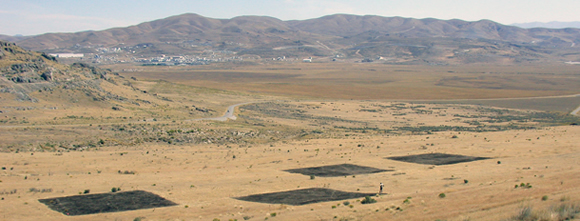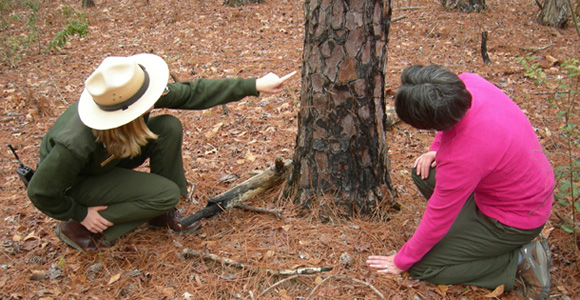This article is part of the Wildland Fire Learning In Depth series. It is designed for students who want to learn more about fire. Find the complete series on the Fire subject site.

Fire Effects Monitoring Program
Research on the effects of fire has been occurring for years in the national parks. It is an important basis of decision making for park and fire managers.
Why does the National Park Service monitor?
Fire is a powerful and enduring force that has had, and will continue to have, a profound influence on National Park Service (NPS) lands. Restoring and maintaining this natural process are both important management goals for many NPS areas. Therefore, information about the use and effect of prescribed fire on park resources is critical to sound, scientifically based management decisions. Using results from a high quality monitoring program to evaluate a park’s prescribed fire management program is the key to successful adaptive management. By using monitoring results to determine whether management objectives are being met, managers can verify that the program is on track, or conversely, discern clues as to what may not be working as planned so that appropriate changes can be made.
The fire monitoring program allows the National Park Service to document basic information, to detect trends, and to ensure that parks meet their fire and resource management objectives. From identified trends, park staff can articulate specific concerns, develop hypotheses, and identify specific research projects to develop solutions to problems.
The Goals of the Program
-
Document basic information for all wildland fires, regardless of management strategy
-
Document fire behavior to allow managers to take appropriate action on all fires that either have the potential to threaten resource values or are being managed under specific constraints, such as a prescribed fire or use fire
-
Document and analyze both short-term and long-term prescribed fire effects on vegetation
-
Establish a recommended standard for data collection and analysis techniques to facilitate the sharing of monitoring data
-
Follow trends in plant communities where fire effects literature exists, or research has been conducted
-
Identify areas where additional research is needed
Monitoring the effects of fire on park ecosystems is an important part of the Wildland Fire Program. Fire managers need to accurately predict fire behavior under varying weather conditions and predict how fire will affect fuel loads, plant populations, and tree regeneration. The fire effects crew monitors prescribed fires and hazard fuel treatment areas to ensure that management objectives are met and that harmful effects are not occurring. The crew also studies natural ignitions to better understand the role of lightning-caused fire and how management may balance the natural fire regime with visitor safety and resource protection.
Standard Data Collected Include:
-
Shrub and herbaceous vegetation composition and abundance
-
Tree density, diameter, and health by species and size class
-
Fuel load by size class (1-hr, 10-hr, 100-hr, and 1000-hr fuels)
-
Litter and duff depth
-
Average scorch height (post-burn)
-
Percent crown scorch (post-burn)
-
Burn severity (Post-burn)
-
Visual changes at permanent photo points
The Process
Vegetation is sampled prior to burning or mechanical treatment, immediately after, and at 1-, 2-, 5-, and 10-year intervals. After collection, the data are entered into a database and stored for analysis. The data allow resource managers and scientists to compare pre- and postburn vegetation composition and fuel loadings and assess whether burn objectives were met, and to track long-term ecosystem changes due to fire.

Results
Learning the effects of fire on a landscape is a valuable tool for park and fire managers as well as scientists.
Scientists have studied the effects of fire in national parks since the early 1950s. Research continues in many parks, including Everglades National Park in Florida, Dinosaur National Monument in Colorado, and Yosemite National Park in California. Valuable lessons have been learned.
-
Scientists found that 33 native plant species in Everglades National Park depend on fire for long-term survival.
-
Restoration research at Dinosaur National Monument showed that native grasslands increased by prescribed burning unnatural concentrations of sagebrush at critical growth stages.
-
Research in Yosemite National Park showed that white fir trees act as ladders that fire can climb to the crowns of giant sequoia trees. Naturally occurring ground fires formerly killed many white fir trees. This natural process is now replicated by prescribed fires that protect the giant sequoia groves.
By burning intensely in some areas and less intensely in others, fire can create a puzzle-like mosaic of diverse habitats for plants and animals. Hawks and other birds of prey hunt along the edges of burned areas and find cover in unburned areas. Deer feed on nutritious, succulent new shoots of grasses and shrubs that appear after fire.
Some plants cannot reproduce without fire. Cones of jack pine and lodgepole pine in northern U.S. forests are sealed with pitch. Fire must melt the pitch to release the seeds. Fire breaks open the outside coating of mountain lilac seeds and stimulates germination in southern California chaparral. Without fire, seeds can lie dormant in the soil for decades. Aspen, birch, and willow sprout from their roots after a fire.
Part of a series of articles titled Wildland Fire - Learning In Depth.
Last updated: January 2, 2017
